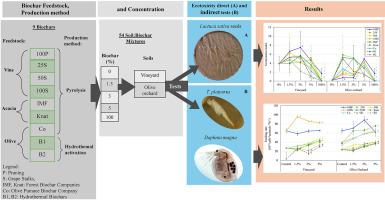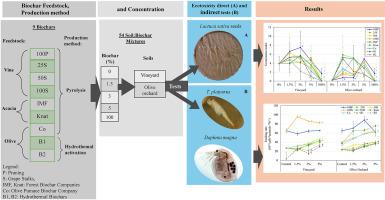Feedstock and pyrolysis conditions of biochars: influence on soil phytotoxicity and water ecotoxicity
IF 10.3
1区 农林科学
Q1 SOIL SCIENCE
引用次数: 0
Abstract
The use of biochar for soil restoration requires understanding ecological trade-offs, particularly how feedstock selection, dose, and production methods influence soil and aquatic ecotoxicity. The ecotoxicological effects of nine biochars derived from vineyard residues, Acacia wood, and olive pomace were evaluated after mixing them at rates of 1.5–5 % into two agricultural soils. Additionally, specific details of the biochar production method were assessed: blending ratios (vine pruning:stalks), pyrolysis temperature, (for Acacia wood) and hydrothermal activation method (for olive pomace). Physicochemical characterization—pH, electrical conductivity, organic matter, carbon and nitrogen content, polycyclic aromatic hydrocarbons (PAHs), FTIR spectroscopy and inertinite content—was combined with ecotoxicological assessment (Lactuca sativa L. phytotoxicity test and aquatic lethal and sub-lethal bioassays with Daphnia magna and Thamnocephalus platyurus). Vineyard pruning and shredded Acacia biochars, which had higher OM contents and lower EC and PAH concentrations, showed the lowest toxicity in soils and aqueous extracts. Soil mixed with biochar at 3–5 % blends optimally restored acidic soils through pH neutralization and moisture retention, which favoured seed growth. The aquatic assays showed stimulatory effects on D. magna feeding rates, increasing by 20–90 % at 5 % biochar concentration. Finally, production assessment revealed that both blending ratios and pyrolysis temperature caused minimal variability in organisms' responses. Hydrothermal activation reduced PAH content (<0.08 mg kg−1) but failed to reduce salinity-driven ecotoxicity. These results suggest that 3–5 % wood-derived biochars are suitable to restore soils without risk to aquatic ecosystems. Olive pomace and vine stalk alternatives need a pre-application screening to detect PAHs and salinity conditions, essential factors affecting physicochemical properties of agricultural soils and environmental safety.


生物炭的原料和热解条件对土壤植物毒性和水生态毒性的影响
使用生物炭进行土壤恢复需要了解生态权衡,特别是原料选择、剂量和生产方法如何影响土壤和水生生态毒性。以1.5-5%的比例混合在两种农业土壤中,评估了从葡萄园残留物、金合欢木和橄榄渣中提取的9种生物炭的生态毒理学效应。此外,对生物炭生产方法的具体细节进行了评估:混合比例(葡萄修剪:秸秆),热解温度(相思木)和水热活化方法(橄榄渣)。理化特性分析——ph、电导率、有机质、碳氮含量、多环芳烃(PAHs)、红外光谱(FTIR)和惰性质含量——结合生态毒理学评价(Lactuca sativa L.植物毒性试验、水蚤(Daphnia magna)和沙棘(Thamnocephalus platyurus)水生致死和亚致死生物试验)。葡萄园修剪和金合欢碎生物炭对土壤和水浸液的毒性最低,OM含量较高,EC和PAH浓度较低。3-5%混合比例的生物炭土壤通过pH中和和保湿恢复酸性土壤,有利于种子生长。水生试验表明,在5%的生物炭浓度下,对D. magna的取食率有刺激作用,提高了20-90%。最后,生产评估显示,混合比例和热解温度对生物响应的影响最小。水热活化降低了多环芳烃含量(0.08 mg kg-1),但未能降低盐度驱动的生态毒性。这些结果表明,3-5%的木质生物炭适合恢复土壤,而不会对水生生态系统造成风险。橄榄渣和藤茎替代品需要在施用前进行筛选,以检测多环芳烃和盐度条件,这是影响农业土壤理化性质和环境安全的重要因素。
本文章由计算机程序翻译,如有差异,请以英文原文为准。
求助全文
约1分钟内获得全文
求助全文
来源期刊

Soil Biology & Biochemistry
农林科学-土壤科学
CiteScore
16.90
自引率
9.30%
发文量
312
审稿时长
49 days
期刊介绍:
Soil Biology & Biochemistry publishes original research articles of international significance focusing on biological processes in soil and their applications to soil and environmental quality. Major topics include the ecology and biochemical processes of soil organisms, their effects on the environment, and interactions with plants. The journal also welcomes state-of-the-art reviews and discussions on contemporary research in soil biology and biochemistry.
 求助内容:
求助内容: 应助结果提醒方式:
应助结果提醒方式:


